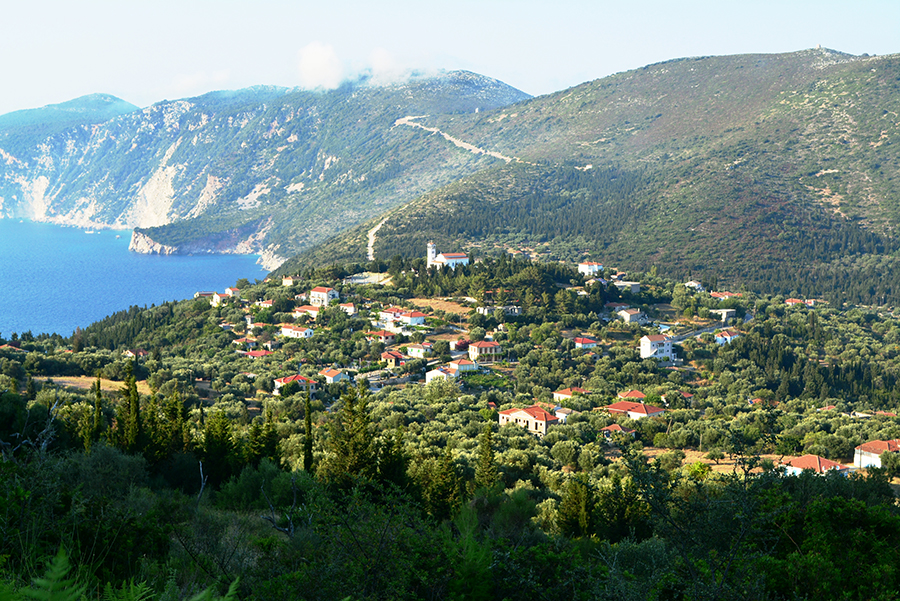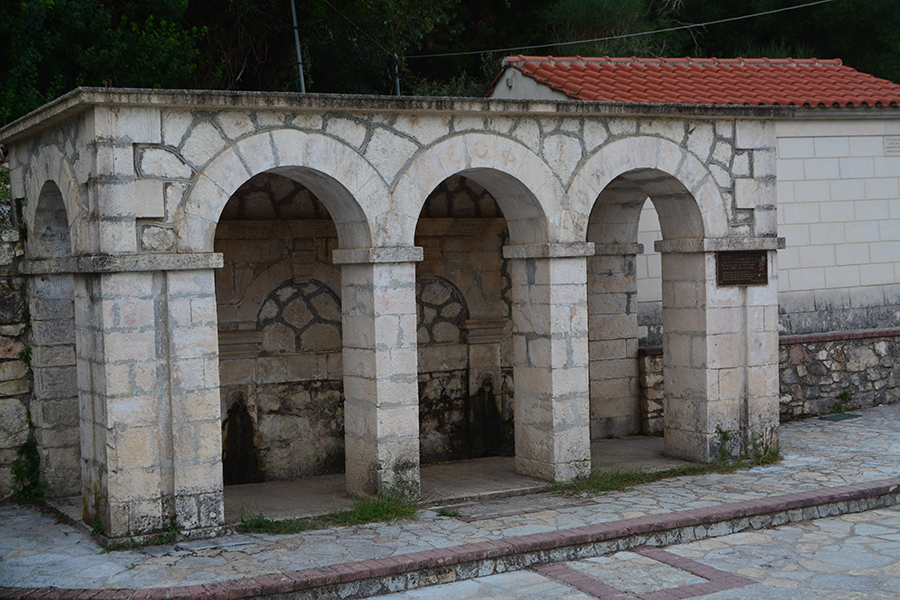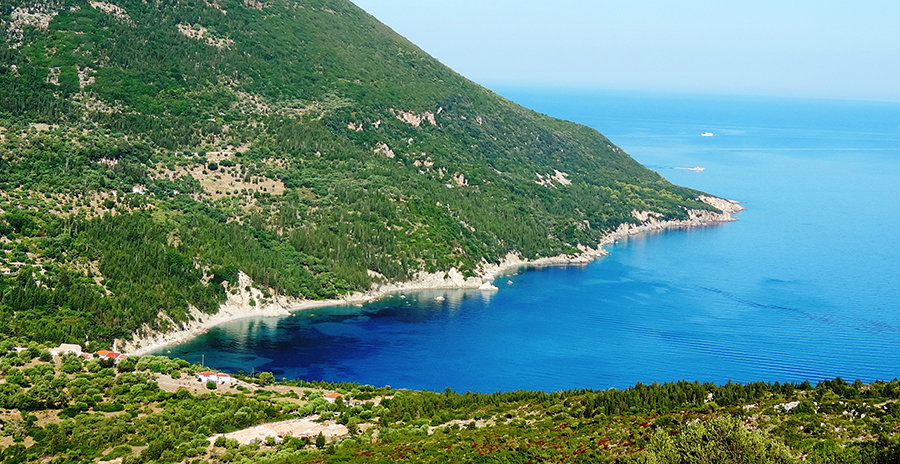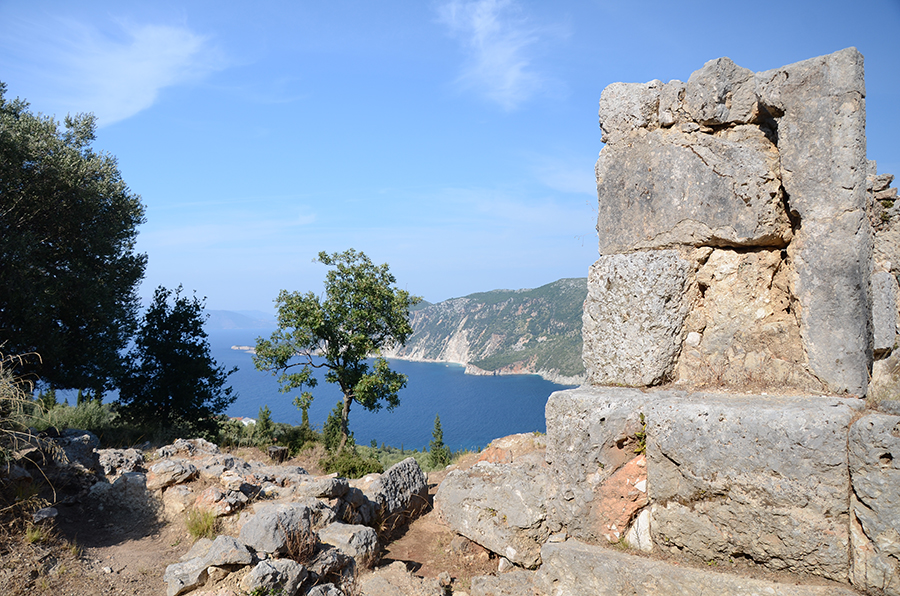Home > Were to stay > Villages > Platrithias
Platreithias is the most dispersed village on the island of Ithaca. It is to be found in the north, 20 km from Vathy and 2 km from Stavros. It has approximately 210 permanent inhabitants and is made up of smaller settlements-Bouzos or Kanalia, Kollieri, Lofos, central Platreithias, Agii Saranta, Lakos, Misovouno, Marmakas and Frikes. It is very likely that the village takes its name from the dry river which traverses the area and was known as ‘Platy Reithron’.
You enter Platreithias from Kanalia, at the crossroads of the road to Exogi. Your road leads you to the triangle of roads, home of the ‘bridge’ and the only restaurant in this immediate neighbourhood. Taking the road directly to Kollieri you will come across the ‘Nikos Defteraios’ park from where you can enjoy views of Afales Bay and, just a little further along, the open-air Stathis Raftopoulos museum of outdoor artworks.
Further beyond the museum, at Kollieri, the road forks. If you go left, you can visit Upper Kollieri or if you go right, you will come across the only running spring on the island at Kalamos. This clear, fresh water spring has been running for thousands of years and has quenched the thirst of thousands including that of Lord Byron, Heinrich Schliemann, Queen Frederica, Aristotle Onassis and Jackie Kennedy. Walkers can follow a well-maintained pathway from Kalamos to Exogi or another to Perivoli beach in Afales Bay. Local residents are very regular users of both paths as they use them to collect water or go swimming.



A few metres down to your left from Gefyri, is the road which leads to the beach at Afales. The road to the sea wanders down through almost tropical vegetation before reaching the refreshing, clear sea. The bay itself has a pebbled beach and is embraced by rocky outreaches which hide three secluded smaller beaches, Ammoudaki, Kouloumi and Perivoli. These small beaches and their waters are an ideal place for swimmers to take their first steps as spear fishermen.
A number of other smaller beaches, Platys Ammos, Sykia and Kathisma are only accessible by boat and are everybody’s dream holiday spots. Their turquoise coloured waters, sand and pebble beaches and steep cliffs provide a summer-long attraction for the hundreds of yachts and motor vessels that visit these waters.
To reach the main square, ‘Limnes’, you should follow the main road from Gefyri. This central square plays host to a series of cultural events during the summer highlighted by the celebrations for August 15th, Dormition of the Virgin Mary-Panagia, which attracts large crowds. Just beyond the square is a small rise, Taxiarches, with the church of the same name, offering gorgeous views over the village to Afales Bay.
The next neighbourhood is Agioi Saranta where you can wonder at the work of the Italian architect and ironist Bruno Mazzali, which covers almost all of the interior walls of the local church.
Following the road ‘down’, you come to the road which will lead to Panagia in Skala. This short journey ‘takes your breath away’ as it opens full vistas to the magnificent Afales Bay. You can also visit the only remaining functioning windmill on the island. Just beyond is the small church of Panagia which celebrates every 15th of August when, following the service, local cultural groups offer the congregation and visitors servings of goat, sweets and refreshing drinks. Those who stay beyond the afternoon are rewarded by a most breath-taking sunset best seen from the windmill.
The best way to continue your journey to Alykes and Marmakas beaches is in a 4×4 vehicle. Both are small-pebbled beaches with tall eucalyptus trees offering shade and a common view of the island of Agios Nikolaos. In the summer season a small canteen operates to care for the needs of visitors who can also reach here by driving from Frikes…but, only in a suitable vehicle as the road can sometimes be difficult!
No introduction to Platreithias would be complete without making reference to the Archaeological site of Agios Athanasios also known as ‘Homer’s School’.
Follow the road to Exogi and after 100 metres or so a right turn takes you to a dirt road leading to the heights of Exogi and to Platreithias. It is here that you will find Homer’s School, ancient remains of primarily Mycenaean buildings. Litsa Kontorli-Papadopoulou, emeritus professor of the University of Ioannina, who carried out the excavations, declared in August 2010 that this is indeed the site of Ulysses’ Palace. His palace includes rooms built on two levels. It features a stone entrance step and an internal double set of stairs, underground food warehouses, mosaic flooring, underground water supplies and drains as well as external walls. The surrounding area has been classified as a site of important archaeological interest and the land is now owned and the site maintained by the Hellenic Ministry of Culture, Education and Religious Affairs.
Οι διαθέτοντες 4χ4 μπορούν να συνεχίσουν προς τα κάτω, σε μια μαγευτική διαδρομή για να φτάσουν στις παραλίες Αλυκές και Μάρμακας. Η τοποθεσία είναι υπέροχη με ωραία βοτσαλωτή παραλία, τεράστιους ευκαλύπτους, που δίνουν σκιά, ενώ στη μέση δεσπόζει το νησάκι Αγ. Νικόλαος. Τους καλοκαιρινούς μήνες λειτουργεί καντίνα. Σημειώνουμε ότι η περιοχή είναι προσβάσιμη και από τις Φρίκες. Ενδείκνυται μόνο αν έχετε το κατάλληλο αυτοκίνητο, καθώς θα φτάσετε από έναν δύσκολο χωματόδρομο.







